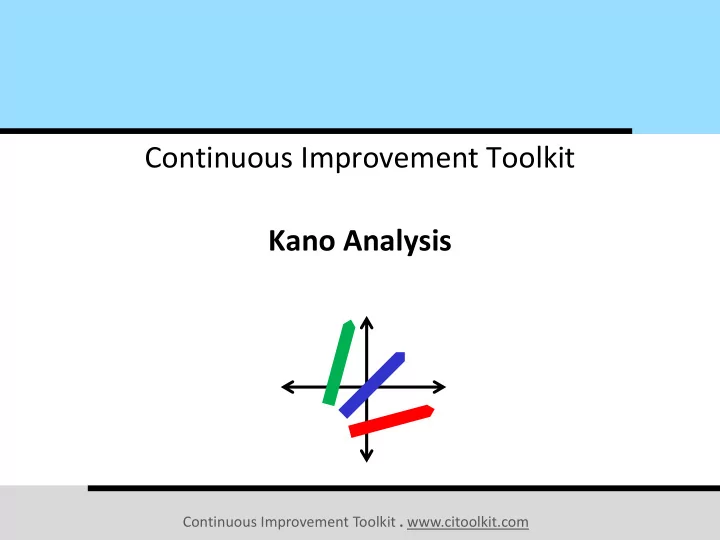

Continuous Improvement Toolkit Kano Analysis Continuous Improvement Toolkit . www.citoolkit.com
The Continuous Improvement Map Managing Deciding & Selecting Planning & Project Management* Risk PDPC Decision Balance Sheet Importance-Urgency Mapping Daily Planning PERT/CPM RAID Log* Force Field Analysis Cost Benefit Analysis FMEA MOST RACI Matrix Activity Networks Break-even Analysis Voting TPN Analysis Risk Assessment* SWOT Analysis Stakeholder Analysis Decision Tree Pick Chart Four Field Matrix Fault Tree Analysis Project Charter Improvement Roadmaps Critical-to Tree QFD Portfolio Matrix Traffic Light Assessment PDCA Policy Deployment Gantt Charts DMAIC Paired Comparison Matrix Diagram Kano Analysis Lean Measures Kaizen Events Control Planning Prioritization Matrix Pugh Matrix Cost of Quality* Bottleneck Analysis** A3 Thinking Standard work Document control C&E Matrix Pareto Analysis OEE KPIs Implementing Cross Training Understanding Process Yield ANOVA Chi-Square Descriptive Statistics Solutions** Cause & Effect Value Analysis Capability Indices Probability Distributions Hypothesis Testing Ergonomics Mistake Proofing Design of Experiment Gap Analysis* Multi vari Studies Histograms & Boxplots Automation Simulation TPM Confidence Intervals Reliability Analysis Graphical Analysis Scatter Plots Pull Flow Just in Time Correlation Regression Understanding MSA 5 Whys Run Charts Visual Management 5S Root Cause Analysis Performance Data Snooping Control Charts Quick Changeover Fishbone Diagram Tree Diagram* Waste Analysis Benchmarking** SIPOC* Time Value Map Sampling Morphological Analysis Process Redesign Data collection planner* How-How Diagram** Value Stream Mapping Brainstorming Spaghetti Diagram Check Sheets SCAMPER** Attribute Analysis Interviews Service Blueprints Flow Process Charts Affinity Diagram Questionnaires Relationship Mapping* Focus Groups Data Flowcharting IDEF0 Process Mapping Mind Mapping* Lateral Thinking Observations Collection Creating Ideas Designing & Analyzing Processes Suggestion systems Continuous Improvement Toolkit . www.citoolkit.com
- Kano Analysis A framework to analyze customer needs . Helps understanding how a product or service fits customer needs. Helps categorizing and prioritizing the different features of a product or service: • Based on their impact to customer satisfaction. Those categories are then considered when analyzing potential opportunities for improvement. Continuous Improvement Toolkit . www.citoolkit.com
- Kano Analysis The types of features that influence customer satisfaction: • The must be features. • The performance features. • The excitement features. • The indifferent features. • The reverse features. Continuous Improvement Toolkit . www.citoolkit.com
- Kano Analysis Must Be Attributes: The basic criteria and the reasonable level of quality. Customers take them for granted. If these requirements are not present or are insufficient: • Customers will be extremely dissatisfied. If they are present or are sufficient: • They will not bring satisfaction. Examples: • The timely & responsive customer service. • The defect-free product. Must Be • The brakes and the windshield of the car. Continuous Improvement Toolkit . www.citoolkit.com
- Kano Analysis Performance Attributes: They are not absolutely necessary. They result in satisfaction when fulfilled Satisfiers and dissatisfaction when not fulfilled. The more you provide, the more the customer is satisfied. Organizations use them to prioritize their efforts. Examples: • The speed of answering a phone in a call center. • The reduced amount of spoilage in a production line. • The warranty period and the fuel consumption of the car. Continuous Improvement Toolkit . www.citoolkit.com
- Kano Analysis Delighters: Organizations should aim for giving customers more than what they expect. Delighters The fulfillment of them will lead to high customer satisfaction. They distinguish your product or service. They are often: • Unexpected and Unspoken. • Provided to the customers for no extra money. An example: A basket of fruit after having booked a room in a hotel. • Continuous Improvement Toolkit . www.citoolkit.com
- Kano Analysis The indifferent attributes are those whose presence and absence do not bring satisfaction. Examples are those product features that are never or rarely used by the customer. Indifferent Continuous Improvement Toolkit . www.citoolkit.com
- Kano Analysis The reverse attributes are those whose presence brings dissatisfaction. Some customers prefer high-tech products, while others prefer the basic model of a product and will be dissatisfied if a product has too many extra features. Reverse Continuous Improvement Toolkit . www.citoolkit.com
- Kano Analysis Revealed Satisfiers Unspoken Delighters Degree of achievement Must Be Unspoken Customer satisfaction Continuous Improvement Toolkit . www.citoolkit.com
- Kano Analysis Using the Kano Model: With your team, brainstorm all of the possible features. Brainstorm everything you can do to excite your customers. Classify all features as basic, satisfier, delighter, indifferent, reverse, or not relevant. Cut out all the indifferent and the non-relevant attributes. Make sure your product has all appropriate basic features. Select the right performance features so that the product can be delivered at a price which the customer is ready to pay. Think how you can build some delighters into your product. Continuous Improvement Toolkit . www.citoolkit.com
- Kano Analysis Tips: The Kano Model highlights how the customer requirements are constantly changing. Today’s delighters becomes tomorrow’s must be’s , requiring us to constantly come up with new delighters. It does not present methods to be applied to carry out improvement activities. Results of applying the Kano Model can be used in the Quality Function Deployment (QFD) matrix to clarify relationship between customer needs and technical requirements. Continuous Improvement Toolkit . www.citoolkit.com
Recommend
More recommend